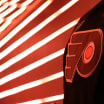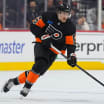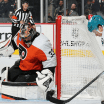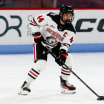Unseen to the public and media last year, the Philadelphia Flyers organization completed a behind-the-scenes overhaul of its training complex home base at the Virtua Flyers Skate Zone in Voorhees, New Jersey. The training facilities, typically off-limits to all but Flyers players, prospects, coaches and executives were fully operational by last season.
During Development Camp in July and Rookie Camp in September, Flyers prospects make extensive use of the facilities. In the meantime, a significant number of current Flyers and Leigh Valley Phantoms spend portions of - or the entire - summer in Voorhees, working out in the complex.
Modeling his same routine from last summer that set up his best NHL season to date, Flyers defenseman Shayne Gostisbehere has again spent the entire summer working out in Voorhees.
Staying Ahead of the Curve
Veterans and prospects taking advantage of Flyers world-class training facility this summer
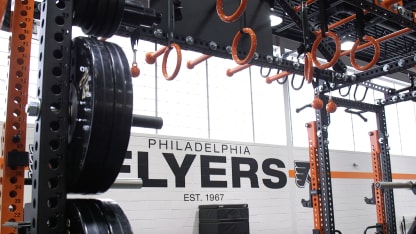
Injury-rehabbing Flyers goalies Brian Elliott and Michal Neuvirth along with Phantoms goalies Alex Lyon and Anthony Stolarz are there as well, along with Phantoms forwards Cole Bardreau and Carsen Twarynski. Free agent acquisition James van Riemsdyk also gave the facilities a test drive when he was in town for his "Flyers reintroductory" press conference.
Earlier this summer, Flyers second-year left winger Oskar Lindblom also spent two-plus weeks in Voorhees. The Swedish forward focused primarily on skating work with Flyers skating coach Slava Kouznetsov.
Whatever the players' needs, the Flyers' state-of-the-art training complex has been designed to meet them. The overhauling process, which was largely directed at the behest of Flyers general manager Ron Hextall and club president Paul Holmgren, took place in phases over the course of several years.

First came an all-new locker room for the Flyers players. Then came an expansion of the gym facilities. Finally, there came the rollout of a spectacular player development and performance center complex that is one of the most extensive and ultra-modern in the National Hockey League. The upstairs office spaces were also overhauled.
In March 2018, Flyers assistant general manager Barry Hanrahan led the media through a tour of the new facilities, which were fully operational before the current season. Many of the areas toured are typically off-limits to all but players, coaches and executives.
Afterwards, Comcast-Spectacor CEO/president David Scott, Holmgren and Hextall met with the media to discuss the new facilities, the process involved and the concept behind it.
"What we've built here is something pretty special that we're all very proud of," Scott said.
"About four years ago, I met with Ron [Hextall] and Paul [Holmgren] to discuss plans for the facility. I remember the day very well, because Homer took me up on the roof to look at the whole property. I have a fear of heights. But we came back and we decided we didn't just want to refurbish this place. We wanted to build something special for the long haul."
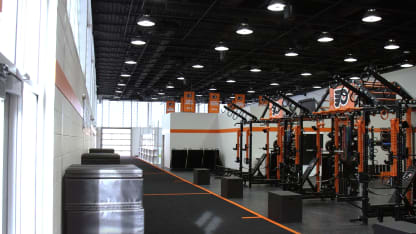
The facilities are geared to giving all players in the Flyers organization, with a greatly increased emphasis on prospects attending Development Camp and Rookie Camp as well as players who work out in Voorhees over the summer, the very best tools to maximize their potential on the ice. All of the bases are covered whether it is skill development resources, (including a room devoted strictly to practice shooting the pick), equipment designed for strength, agility or endurance training, a dedicated recovery room, private meeting rooms, video access and an ever-increasing presence of sports science data, coaching and feedback.
The locker room on the "Phantoms" rink side of the two-rink complex has also been redone. Attendees at Development Camp in July 2017 and Rookie Camp two months later were the first to have use of the new, NHL-caliber locker room and adjoining facilities.
"It's about our commitment to young players. We live in a salary-capped world. It's very important in today's game to have young players, and especially homegrown players. That's a big area of investment and focus in our organization," Hextall said.
"When you develop young players, it's a long process. They are young people. You have to teach them how to train properly. Not just using the equipment and [doing] the reps but things such as nutrition, but the facilities are important as well. Well, maybe Player X has a gym in Wherever, Alberta. Well, we have got a gym. We have a mini-rink where we can do all our skill work. We have a shooting room. We have our nutrition room. We have our sports science department. With players, drafting is one side of the equation but there also has to be a template for their development."
Throughout the new facilities, there are reminders everywhere of the history and identity of the Flyers' organization. The Flyers' crest is omnipresent; whether it is on the walls on every room, the championship banners that hang above a dryland mini-rink, and even emblazoned on the workout equipment itself.
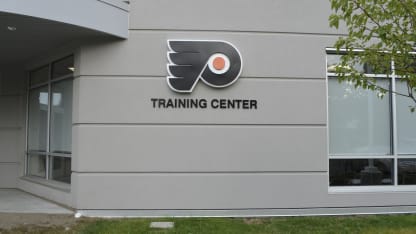
So, too, are homages to great players from team history. A walk through the performance center is a reminder of those who helped forged the team's legacy over more than a half-century. There is also large display honoring the fitness testing winners at training camp over the last 20-plus years. In the upstairs office area, a veritable Flyers mini-museum has been installed.
Not only are the facilities impressive to the eye, they also communicate three very important messages to the players for whom the complex was built:
1) The complex is a tangible embodiment of the old hockey adage "we supply everything but guts"; it is up to each player to show the dedication to take full advantage of the resources available to him.
2) Being part of the Flyers organization means something special, and it starts with everyone collectively putting the team first.
3) There is an opportunity to become part of the next generation of players who builds upon the team-first legacy forged over the decades by the likes of Bob Clarke, Dave Poulin, Eric Desjardins and Danny Briere.
A big part of the Flyers identity, both historically and continuing to the present day, has been to maintain close ties with the fans and the community. Very early in the process, a decision was made to keep the Flyers home base at the open-to-the-public Skate Zone complex, where all Flyers practices are free to attend and at which youth hockey leagues, rec hockey and public skating sessions take place throughout the year.
"We think it's a great thing that kids who come to the rink know that Claude Giroux skated on the same ice at 11 a.m.," Hextall said.
Added Holmgren, "The bones of the building were good. We realized pretty fast we'd be able to stay here and go through the process on the property here."
Holmgren is the only person in franchise history who has served the organization as a player, coach, general manager and president. Sitting in the new press conference room that adjoins the media room overlooking the Flyers' practice rink, Holmgren chuckled when asked to compare what's been built in Voorhees to what was available to NHL players back when the Flyers trained at the Class of the 1923 Rink at the University of Pennsylvania during the 1970s to early 1980s.
"At the Class of '23, we had workout space that was a little smaller than this room. There were weights, [contraptions with] pullies," Holmgren recalled.
Bob Clarke, by the standards of his playing era, was one of the first NHL players who took pride in physical fitness and gym training. After the Flyers won their first Stanley Cup in 1974, team captain Clarke instructed his teammates to report to camp in the best shape of their lives. Most of the guys complied; which in those days meant showing up at camp either at their playing weight or at least no more than a few pounds over it.
Back in the mid-1970s, the Flyers installed an Apollo fitness system at the Class of 1923 rink. Based on the principles of resistance training, the devices were heavily bolted to the wall. The harder the user pulled, the more equivalent resistance he received against his weight.
The training devices, albeit simplistic, were effective when used properly. However, in an era when there was much less year-round emphasis on off-ice fitness and less consequence for taking workout shortcuts, some Flyers players found loopholes. Quickly realizing that the workout became exponentially easier with less counter-weight resistance, some would feign as if they were straining with the pullies, complete with wincing and grunting, but, in reality, applied very little pressure.
Flyers head coach Fred Shero and trainer Frank Lewis were not fooled by the ruse. However, as long as players did not take shortcuts on the ice, Shero was relatively unconcerned about whether they took their other forms of training seriously.
From the mid-1980s to late 1990s, the Flyers' training complex was at the Coliseum in Voorhees. The facilities were a decided upgrade from their former digs.
"The Flyers organization has always believed in providing first-rate facilities to the players. By the standards of the time, the Coliseum was one of the top facilities in the NHL. That said, so much has changed, quite honestly even within the last five years, that you can't even compare that era to now," said Hextall, who was drafted by the Flyers in 1982 and spent two playing stints with the team (1986-87 to 1991-92, 1994-95 to 1998-99) before moving to the scouting and management side of the game.
"We know so much more now, pretty much in every area of training, and it evolves fast. We've worked to be on the cutting edge with incorporating sports science, the nutrition side. It's all part of a bigger picture. When we built the facilities here, we wanted something that incorporates not just what's current today but also to stay ahead of the curve going forward. In today's game, you look for those one-percent and two-percent boosts because everything is competitive."







